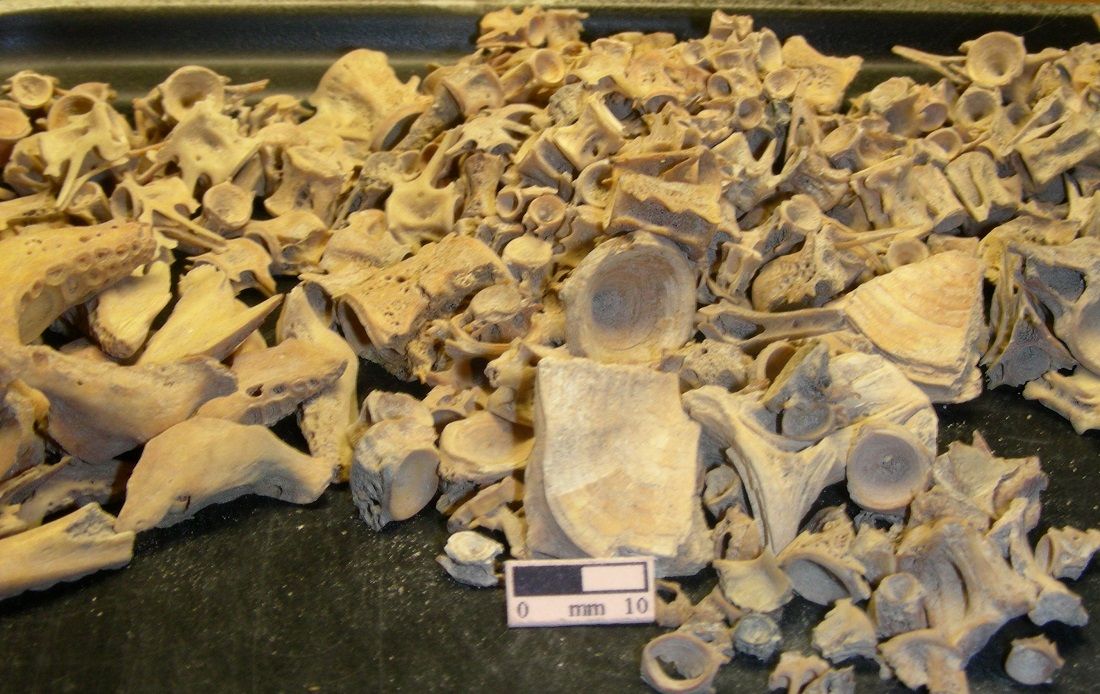 Edit article
Edit articleSeries
What Kinds of Fish Were Eaten in Ancient Jerusalem?

Still Life with Fish Pierre-Auguste Renoir c.1913. Wikiart
The Study of Fishbones
Over the past century and a half, archaeologists have excavated a variety of sites in Jerusalem, bringing to light many aspects of everyday life in the biblical city. The examination of ceramic vessels for cooking and serving, as well as the uncovering of food waste, mainly comprised of discarded bones, have taught us much about the diet of the city’s inhabitants in different periods.
In the early stages of archeology, archeologists concentrated on the bones of larger animals such as sheep, goats, and cattle, but later turned also to shells and the bones of small animals such as birds and fish. As it is very possible to miss such small objects during excavation, the study of these bones was enhanced with the introduction of dry, and especially wet sifting of the excavated soil.
In the latter method, a dirt sample is poured onto a sieve in water. The dirt is then fully unpacked and falls through the holes while other material, especially organic material such a bones, is trapped in the mesh and remains for study.[1]
Fishbones are found in almost every excavation where proper measures of collection are used. The bones tend to preserve fairly well over long periods of time and can be identified taxonomically by using a reference collection of modern fishbones. Moreover, by identifying the type of fish, we can also determine its origin: marine (i.e. saltwater) fish come from either the Mediterranean or the Red Sea, while freshwater fish come from either the Jordan River system, coastal rivers and streams, or from the Nile. This kind of information helps to asses trade connections in ancient times.
In this piece, I shall describe briefly the fish remains excavated and analyzed in eight different areas of ancient Jerusalem from the Bronze Age to the Early Islamic period.
There is no doubt that fish comprised an important part of the diet of the population. Fish had to be imported to Jerusalem mainly from fish markets along the coast. The shelf life of fresh fish is short and therefore, in ancient times they were probably bought in the local market in Jerusalem dried, salted, or smoked.
The House in the Rock-Cut Pool and Building 2482
The largest assemblage of fish bones in Jerusalem was found in the City of David, in an excavation called “The Rock Cut Pool” adjacent to the Gihon spring, carried out by Ronny Reich and Eli Shukrun. During the Middle Bronze Age (early to mid 2nd millennium B.C.E.), a deep large hole was hewn into the rock as part of the intricate water carrying system of the city (despite its modern name it apparently never functioned as a pool).

Hundreds of years later, about the middle of the 8th century B.C.E., a house was built inside this hollow, the floor of which was raised above a thick fill of soil.[2] This fill, which was dated to an earlier period (about the end of the 9th century B.C.E.), was thoroughly wet-sifted by the excavators’ team, and produced among other artifacts, over 10,000 fish bones and several hundred broken clay seals, known as “bullae,” which were used to seal letters or packages and thus, would have been broken when the packages and letters were opened.
It was therefore, suggested that the fill under the floor of the house probably originated from some garbage dump of an administrative center admitting goods imported to the city, including packages containing fish, likely the remains of fish that arrived at the city rotten and were thrown into the garbage with the broken bullae. Moreover, it seems likely that the center itself can be identified.
Near the Rock Cut Pool excavation is another site, known as “Building 2482,” which was excavated by Joe Uziel and Nahshon Szanton. There again fish bones and bullae were found and in exactly the same proportion, strongly implying that building 2482 is the administrative center which dumped its garbage in the Rock Cut Pool.
What Kinds of Fish?
Most of the bones found in these two sites belonged to Sparus auratus, the gilt-head sea bream, locally known as “denis.” This is a marine fish inhabiting the Mediterranean. Isotope analysis of this fish’s teeth from different excavated sites across the country has shown that it was not captured in the open sea but rather imported to the Levant from the Bardawil hypersaline lagoon in Northern Sinai. this lagoon is rich in fish, and large numbers of gilt-head sea breams are caught there even today.

In addition to the gilt-head sea bream, 15 other species of fish were found. All of the fish were kosher, with the major exception of catfish, sharks, and rays. (More on this later.) Most of the bones were from marine fish from the Mediterranean (no Red Sea fish were found), but some freshwater fish, such as the Lates niloticus, the Nile perch, locally known today as “The Princess of the Nile,” were also found there. Nowadays, Nile perch is widely imported from Lake Tanganyika in Kenya, but in the Iron Age, the ancient Egyptians caught this fish, the largest in the Nile, and exported it, probably smoked, all over the Eastern Mediterranean.
This exporting of Nile perch lasted for more than 1500 years, beginning in the Middle Bronze Age and even earlier. Whether or not Nile perch was the fish that the Israelites, in Numbers 11:5, claim to have eaten while they wandered in the wilderness, “We remember the fish that we used to eat free in Egypt” (זָכַרְנוּ אֶת הַדָּגָה אֲשֶׁר נֹאכַל בְּמִצְרַיִם חִנָּם), their descendants were able to enjoy this (and other) Egyptian fish throughout the First Temple Period.
The rich assortment of fish consumed by Jerusalemites during the First Temple period points to a community interested in maintaining multiple sources of food, through diverse sources of commerce. Nehemiah 3:3, a Persian Period source, in describing the reconstruction of the walls of Jerusalem, explicitly mentions “the fish gate” (שַׁעַר הַדָּגִים; Neh 3:3), which likely functioned as a fish market. Moreover, Nehemiah explicitly makes reference to Tyrian fisherman:
נחמיה יג:טז וְהַצֹּרִים יָשְׁבוּ בָהּ מְבִיאִים דָּאג וְכָל מֶכֶר וּמֹכְרִים בַּשַּׁבָּת לִבְנֵי יְהוּדָה וּבִירוּשָׁלִָם.
Neh 13:16 Tyrians who lived there brought fish and all sorts of wares and sold them on Shabbat to the Judahites in Jerusalem.
This illustrates how even in the smaller Second Temple city of Jerusalem in the Persian period, it was still worthwhile for coastal Phoenicians to show up in Jerusalem and sell their fish to the local Judeans, again dried, salted, or smoked.
Other City of David Excavations
Other more modest assemblages give us a further glimpse of fish consumption during later periods.
Shilo’s Excavation (Late First Temple Period)
The first study of fish bones in Jerusalem was based on a small assemblage of 245 bones uncovered in the excavations of the City of David in the 1980s by Yigal Shilo. Most of the bones were dated to the late Iron Age, First Temple period, around the 7th century B.C.E.
In one building located in area G, known as “The House of Ahikam,” eight kinds of fish were found, including Nile perch, as well as freshwater catfish and tilapia, marine porgies, meagre, mullets and sea bass, and another kind of catfish imported from the Nile. These, together with other finds in the same building, suggest a high economic and social status of the inhabitants.
Mazar’s Excavation (Late First Temple Period)
Another assemblage of 530 fish bones was found in an excavation led by Eilat Mazar dated to the end of the First Temple period, and to the short Babylonian and later Persian periods. These were the same types of fish found in the Rock Cut Pool and Building 2348 excavations, including gilt-head bream from Lake Bardawil and Nile perch, both imported from Egypt.
Gadot’s Excavation (Second Temple Period)
A site excavated by Yuval Gadot provides information about the consumption of fish in the Early Roman Second Temple period. A thick layer of garbage from this period covers the remains of the Iron Age city along the eastern slopes into the Kidron River. Wet sifting of the dirt produced 590 fish bones mainly from the Mediterranean but also from the Sea of Galilee.
Reich and Shukron’s Excavation (Second Temple Period)
Also dated to the Early Roman Second Temple period is another layer of garbage, east of the Temple Mount, and excavated by Reich and Shukrun. They dubbed this site “the Holy Dump,” since the thick dirt piles they dug through appear to hold the remains of the Second Temple’s trash. The dirt here yielded remains of what seems to have been sacrificial animals, and also about 300 bones of fish of the same kinds found in the other digs surveyed above.
Amit and Wolff’s Excavation (Byzantine)
A small number of fish bones were found in the remains of an Armenian monastery dated to the Byzantine period excavated by David Amit and Sam Wolff. Among them were again the remains of Nile perch, attesting to the very long period of Egyptian trade in these fish.
Ben Ami Excavation (Early Islamic)
Another small assemblage of fishbones was found in garbage pits from the Early Islamic period by the Givati Parking Lot Excavation led by Doron Ben Ami. These pits were thought to have served as trash for a local market, and fishbones were found in two of them. There were 320 bones, half of them belonged to freshwater catfish and a few to parrot fish from the Red Sea. As a small Islamic town on the northern coast of the Red Sea near today’s Eilat was in existence at the time, these remains suggest trade connections between this town and Jerusalem.
Treif Fish in Jerusalem?
According to the Torah, only fish with fins and scales may be eaten (Deut 14:9–10, ≅ Lev 11:9–12):
דברים יד:ט אֶת זֶה תֹּאכְלוּ מִכֹּל אֲשֶׁר בַּמָּיִם כֹּל אֲשֶׁר לוֹ סְנַפִּיר וְקַשְׂקֶשֶׂת תֹּאכֵלוּ. יד:י וְכֹל אֲשֶׁר אֵין לוֹ סְנַפִּיר וְקַשְׂקֶשֶׂת לֹא תֹאכֵלוּ טָמֵא הוּא לָכֶם.
Deut 14:9 These you may eat of all that live in water: you may eat anything that has fins and scales. 14:10 But you may not eat anything that has no fins and scales: it is unclean for you.
Nevertheless, each of these assemblages of fish bones from Jerusalem contained remains of catfish and cartilaginous fish (sharks and rays) none of which have scales. Their remains in the set of excavations in Jerusalem were quite common during the First Temple and Persian periods (up to 25%), rare in the later Second Temple period (less than 3%), and then again common in the Byzantine and Early Islamic periods (up to 50%).
These findings suggest that the laws concerning pure and impure fish either evolved or became generally accepted among Jews only during the post-Persian Second Temple period.
TheTorah.com is a 501(c)(3) nonprofit organization.
We rely on the support of readers like you. Please support us.
Published
June 19, 2019
|
Last Updated
April 9, 2024
Previous in the Series
Next in the Series
Footnotes

Prof. Omri Lernau, M.D. is a general surgeon, specializing in pediatric surgery; before his retirement, he was head of the surgery department in Shaare Zedek Medical Center in Jerusalem. In addition, Lernau is a zooarchaeologist working with Haifa University’s Zinman Institute of Archaeology, with an expertise in the study of fish remains. As such, he has worked with most of the excavations that occur in Israel, wherever fishbones have been found, studying and publishing the findings.
Essays on Related Topics:





